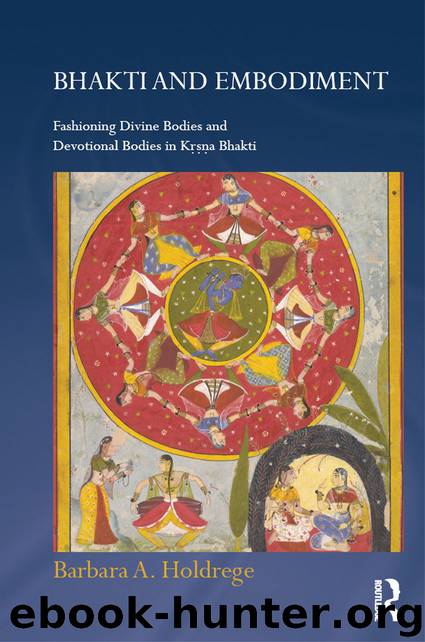Bhakti and Embodiment by Barbara A Holdrege

Author:Barbara A Holdrege [Holdrege, Barbara A]
Language: eng
Format: epub
ISBN: 9780415670708
Publisher: Taylor & Francis (CAM)
Published: 0101-01-01T00:00:00+00:00
The Six Gosvāmins of Vṛndāvana
As discussed in the Introduction, Caitanya is represented in Kṛṣṇadāsa Kavirāja’s Caitanya Caritāmṛta and other hagiographies as instructing Rūpa Gosvāmin and Sanātana Gosvāmin to go from Bengal to Vraja, recover the lost līlā-sthalas of Vraja-maṇḍala, and establish temples and shrines to visibly mark the sites of Kṛṣṇa’s playful exploits as tīrthas.165 The two brothers, in accordance with Caitanya’s instructions, settled permanently in Vraja—Rūpa in 1516 and Sanātana in 1517—and established two of the most important temples in Vṛndāvana: the Govindadeva temple and the Madanamohana temple.
Rūpa is credited in hagiographic accounts with discovering the black stone mūrti of Govindadeva, the presiding deity of Vṛndāvana, which, as mentioned in the Introduction, is revered as a svayam-prakaṭa (self-manifested) mūrti that revealed itself to him in 1533 or 1534 at the site of the original yoga-pīṭha where Kṛṣṇa and Rādhā enjoyed their nightly trysts. Rūpa then established the Govindadeva temple to house the mūrti. A new Govindadeva temple in red sandstone was subsequently built on the site in 1590 by Rājā Mān Siṅgh of Amber (r. 1589–1614 CE), who was the highest ranking Hindu officer in the court of the Mughal emperor Akbar (r. 1556–1605 CE). The largest of the Hindu edifices built during the reign of Akbar as part of his court’s royal patronage of Vraja, the Govindadeva temple is described by Frederick S. Growse, in his 1883 district memoir of Mathurā, as the “most impressive religious edifice that Hindu art has ever produced, at least in Upper India.”166 In the latter half of the seventeenth century iconoclastic attacks were made on the temples of Mathurā and Vṛndāvana at the behest of the Mughal emperor Aurangzeb (r. 1658–1707 CE), and the original mūrti of Govindadeva was removed from the temple in Vṛndāvana and taken to a series of safer locales, eventually becoming established in a new temple built by Mahārājā Jai Siṅgh II (r. 1700–1743 CE) at the center of his palace in his newly constructed royal city of Jaipur.167
Sanātana Gosvāmin is credited in hagiographic accounts with recovering the mūrti of Kṛṣṇa as Madanamohana, enchanter of the god of love, from the wife of a Chaube brahmin and installing the deity for worship on the Dvādaśāditya mound above the Yamunā. Sanātana subsequently oversaw the establishment of the Madanamohana temple at the site, another impressive edifice in red sandstone that was constructed with funds provided by a wealthy merchant. During the iconoclastic raids of the late seventeenth century, the original mūrti of Madanamohana, like that of Govindadeva, was removed from Vṛndāvana and was eventually established in a new temple built by Mahārājā Gopāla Siṅgh opposite his palace in Karauli, a small town southeast of Jaipur.168
Rūpa and Sanātana were joined in Vraja by four other disciples of Caitanya, who together are renowned as the “six Gosvāmins of Vṛndāvana” and are credited with recovering many of the lost līlā-sthalas of Vraja, particularly in the areas of Vṛndāvana and Rādhā-kuṇḍa. According to hagiographic accounts, Gopāla Bhaṭṭa Gosvāmin, the son of a Śrīvaiṣṇava brahmin
Download
This site does not store any files on its server. We only index and link to content provided by other sites. Please contact the content providers to delete copyright contents if any and email us, we'll remove relevant links or contents immediately.
| Chakras | Gandhi |
| History | Rituals & Practice |
| Sacred Writings | Sutras |
| Theology |
Fingersmith by Sarah Waters(2483)
Kundalini by Gopi Krishna(2136)
Wheels of Life by Anodea Judith(2095)
Indian Mythology by Devdutt Pattanaik(1898)
The Bhagavad Gita by Bibek Debroy(1897)
The Yoga of Jesus: Understanding the Hidden Teachings of the Gospels by Paramahansa Yogananda(1803)
Autobiography of a Yogi (Complete Edition) by Yogananda Paramahansa(1774)
The Man from the Egg by Sudha Murty(1742)
The Book of Secrets: 112 Meditations to Discover the Mystery Within by Osho(1628)
Chakra Mantra Magick by Kadmon Baal(1616)
The Sparsholt Affair by Alan Hollinghurst(1545)
Sparks of Divinity by B. K. S. Iyengar(1491)
Gandhi by Ramachandra Guha(1485)
Avatar of Night by Tal Brooke(1484)
Karma-Yoga and Bhakti-Yoga by Swami Vivekananda(1467)
The Bhagavad Gita (Classics of Indian Spirituality) by Eknath Easwaran(1452)
The Spiritual Teaching of Ramana Maharshi by Ramana Maharshi(1401)
Hinduism: A Very Short Introduction (Very Short Introductions) by Knott Kim(1344)
Skanda Purana (Great Epics of India: Puranas Book 13) by Bibek Debroy & Dipavali Debroy(1338)
